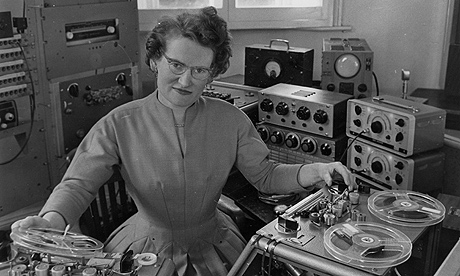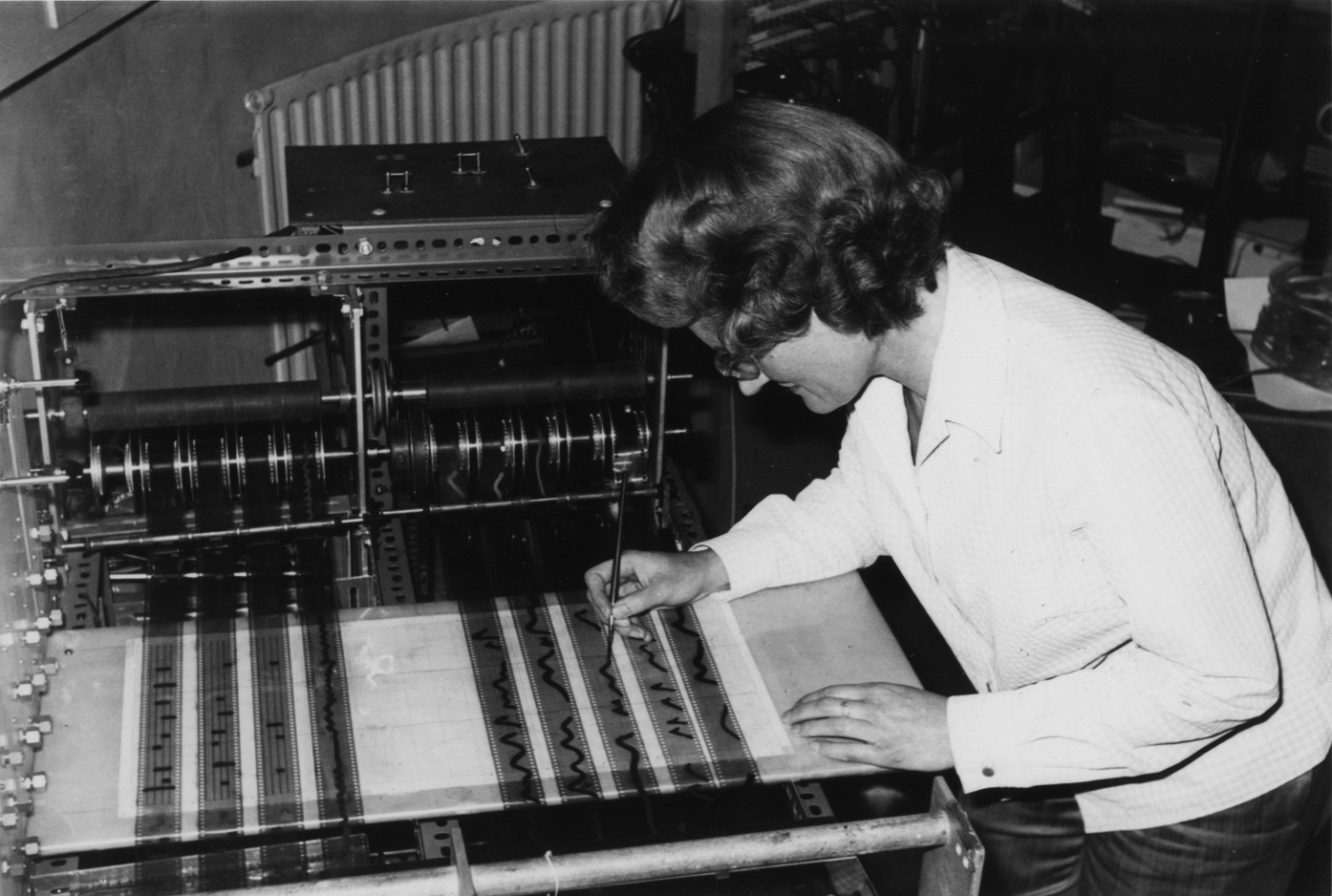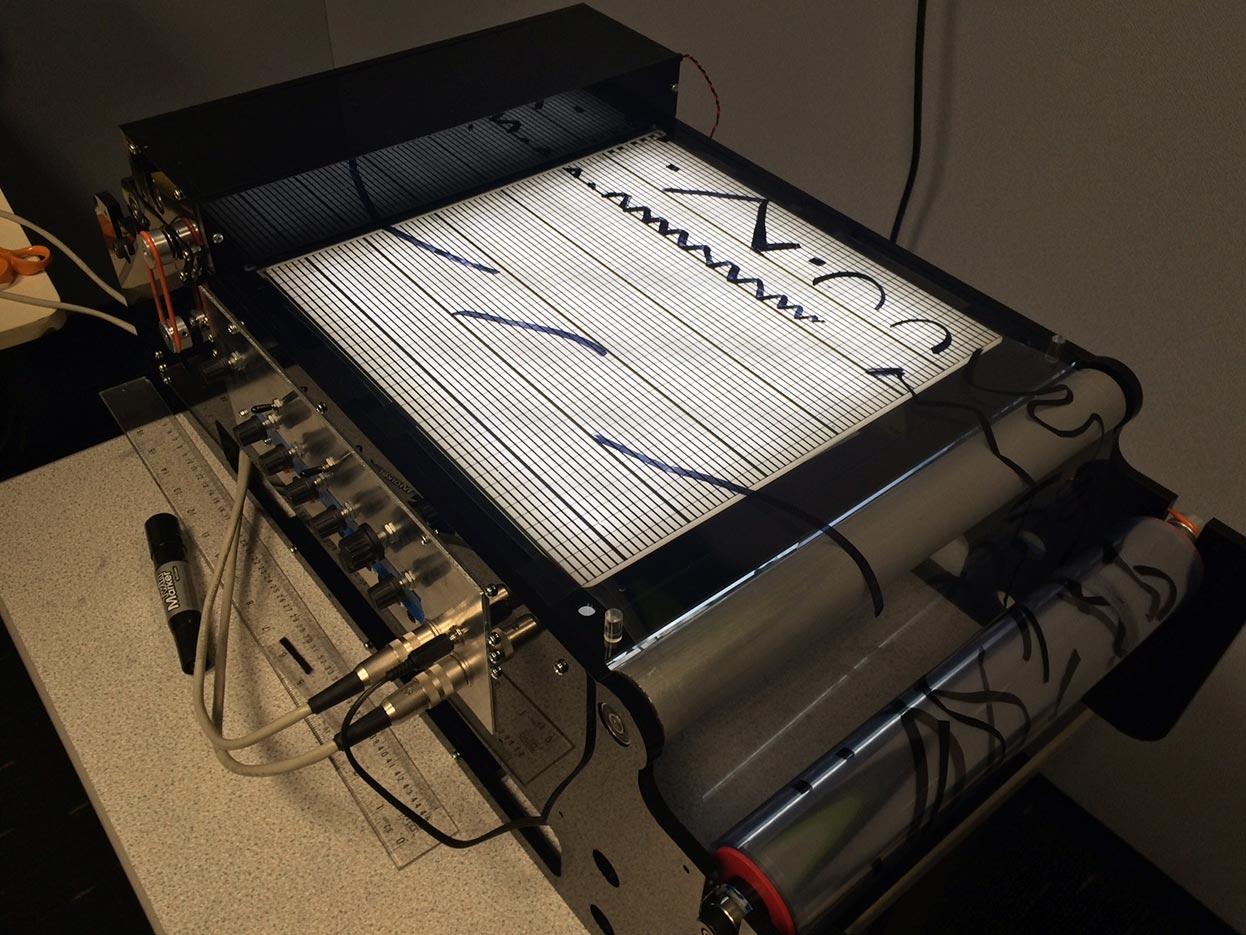Du verwendest einen veralteten Browser. Es ist möglich, dass diese oder andere Websites nicht korrekt angezeigt werden.
Du solltest ein Upgrade durchführen oder einen alternativen Browser verwenden.
Du solltest ein Upgrade durchführen oder einen alternativen Browser verwenden.
oramics synthesizer
- Ersteller orgo
- Erstellt am
orgo
|||

This video, via filmmaker Nick Street, offers a glimpse of Daphne Oram‘s unique Oramics synthesiser, designed in 1957, after she left the BBC Radiophonic Workshop.
The machine, recently acquired by Goldsmiths College, is now in the hands of The Science Museum in London and is currently being restored. It hasn’t been performed with since the 1970s.
The Oramic synthesizer works by translating images on 35mm film strips into control voltages that affect amplitude, frequency, etc.
Oram, 1925 – 2003, is a unique character in the history of electronic music, managing early electronic music studios, creating pioneering electroacoustic works, establishing the BBC Radiophonic Workshop, and developing her own synthesizer.
For more information on Daphne Oram and her machine, check out daphneoram.org
oli
*****
Hier geht es auch u.a. ums Oramics

 www.ableton.com
www.ableton.com
(den Link hab ich hier gefunden in diesem Thread -> https://www.sequencer.de/synthesizer/threads/eine-kurze-geschichte-des-studios-als-instrument-teil-1.118150/#post-1386745 )

Kurze Geschichte des Studios als Instrument: Teil 1
Teil 1 von „Eine kurze Geschichte des Studios als Instrument“ verortet die Anfänge der Klanggestaltung im Samplen, Loopen und in kreativer Aufnahmepraxis.
(den Link hab ich hier gefunden in diesem Thread -> https://www.sequencer.de/synthesizer/threads/eine-kurze-geschichte-des-studios-als-instrument-teil-1.118150/#post-1386745 )
oli
*****
2011 wurde das Oramics ausgestellt im Science Museum in London.
Dort ist in dem Zuge auch eine Touchscreen-Version als Installation entstanden sowie eine App fürs iPad und iPhone.
 www.daphneoram.org
www.daphneoram.org
Dort ist in dem Zuge auch eine Touchscreen-Version als Installation entstanden sowie eine App fürs iPad und iPhone.
‘Oramics to Electronica’ at the Science Museum, London
oli
*****
Tom Richards hat eine Hardware-Version in Miniaturform gebaut während seiner PhD-Zeit.
Er schreibt dazu:
"The original Oramics machine was designed in the early to mid 1960s and was built with funding from the Calouste Gulbenkian Foundation.
It was different to many early forms of electronic synthesisers: the composer/musician drew onto a set of 35mm film strips which ran past a series of photo-electric cells, generating electrical signals to control amplitude, timbre, frequency and duration.
The original Oramics Machine was the size of a large office photocopier, so was too cumbersome for the average musician. In the early 1970s Oram began work on Mini-Oramics (perhaps inspired by Moog’s development of the Minimoog), but as far as we know she never completed a prototype.
“There were a lot of reasons why she didn’t launch Mini-Oramics,” explains Tom. “She was working on her own, she wasn’t affiliated to a large organisation or university.
“She had ups and downs in her life, and at the time she was working on Mini-Oramics, she also worried that her approach to musical research was out of fashion when compared to chance-based and computerised techniques. She was unable to secure the further funding she needed and she eventually moved on to other research.
“In an alternate universe, Mini-Oramics might have become an actual product, bought and used by musicians all over the world.”
The original Oramics machine was designed in the early to mid 1960s and was built with funding from the Calouste Gulbenkian Foundation.
...
Dr Mick Grierson, director of Goldsmiths’ Daphne Oram Archive, and Tim Boon head of research at the Science Museum, invited Tom Richards to do a practice led PhD on the subject of Oramics. Tom decided to re-imagine and then build Mini-Oramics.
“The rules were simple. I had to imagine I was building the machine in 1973, interpreting Daphne Oram’s plans and using only the technologies that existed at that time.”

 www.gold.ac.uk
www.gold.ac.uk
Er schreibt dazu:
"The original Oramics machine was designed in the early to mid 1960s and was built with funding from the Calouste Gulbenkian Foundation.
It was different to many early forms of electronic synthesisers: the composer/musician drew onto a set of 35mm film strips which ran past a series of photo-electric cells, generating electrical signals to control amplitude, timbre, frequency and duration.
The original Oramics Machine was the size of a large office photocopier, so was too cumbersome for the average musician. In the early 1970s Oram began work on Mini-Oramics (perhaps inspired by Moog’s development of the Minimoog), but as far as we know she never completed a prototype.
“There were a lot of reasons why she didn’t launch Mini-Oramics,” explains Tom. “She was working on her own, she wasn’t affiliated to a large organisation or university.
“She had ups and downs in her life, and at the time she was working on Mini-Oramics, she also worried that her approach to musical research was out of fashion when compared to chance-based and computerised techniques. She was unable to secure the further funding she needed and she eventually moved on to other research.
“In an alternate universe, Mini-Oramics might have become an actual product, bought and used by musicians all over the world.”
The original Oramics machine was designed in the early to mid 1960s and was built with funding from the Calouste Gulbenkian Foundation.
...
Dr Mick Grierson, director of Goldsmiths’ Daphne Oram Archive, and Tim Boon head of research at the Science Museum, invited Tom Richards to do a practice led PhD on the subject of Oramics. Tom decided to re-imagine and then build Mini-Oramics.
“The rules were simple. I had to imagine I was building the machine in 1973, interpreting Daphne Oram’s plans and using only the technologies that existed at that time.”

Student builds Daphne Oram’s unfinished ‘Mini-Oramics’
A Goldsmiths, University of London researcher has built a music synthesiser and sequencer designed – but never realised - by electronic music pioneer Daphne Oram more than 40 years ago.
Ähnliche Themen
- Antworten
- 72
- Aufrufe
- 2K
- Antworten
- 61
- Aufrufe
- 14K
- Antworten
- 834
- Aufrufe
- 35K
Neue Beiträge
-
-
Exquis Kickstarter MPE fähiges "Keyboard"/Controller/Kompositionshilfe
- Letzter: Donauwelle
-
-
-
-
News
-
News Umsturz 2026 - SequencerTalk 264 - die letzte in diesem Jahr - live
- Gestartet von Moogulator
- Antworten: 1
-
News 2025-12-20 Shiny Toys, Dortmund - Musik Festival Reihe IV
- Gestartet von Moogulator
- Antworten: 1
-
-
News CRYPTOBIOSIS (Performance-Musik-Mikrobiologie) - in Köln
- Gestartet von Moogulator
- Antworten: 0
-
-
-
News Next-Generation MIDI Controller kommen - eine ganze Ladung
- Gestartet von Moogulator
- Antworten: 1
App installieren
So wird die App in iOS installiert
Folge dem Video um zu sehen, wie unsere Website als Web-App auf dem Startbildschirm installiert werden kann.
Anmerkung: Diese Funktion ist in einigen Browsern möglicherweise nicht verfügbar.
